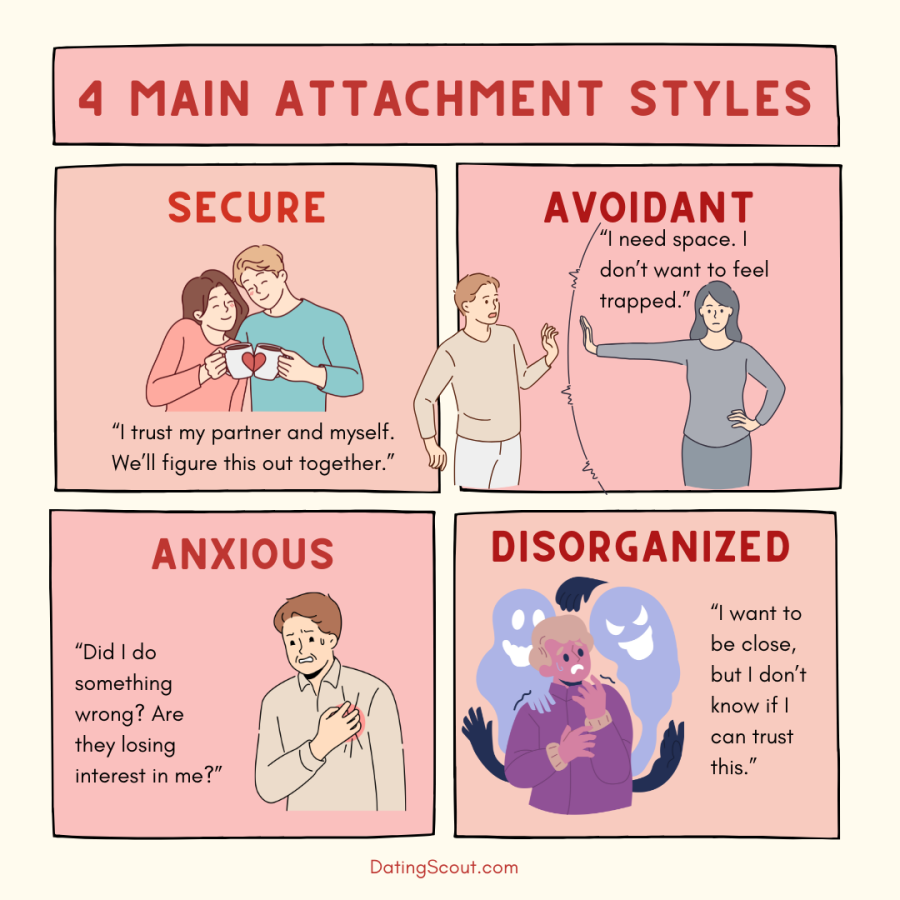What’s Your Attachment Style? Take Our Quiz & Explore All 4 Types
Ever wonder why you act a certain way in relationships? Maybe you get anxious when someone doesn't text back, or you tend to pull away when things get serious. The way you connect with people, especially in love, often comes from something your attachment style. Discovering your attachment style can help you build healthier, happier relationships.
What is an Attachment Style?
Your attachment style is how you emotionally connect with others, especially in close relationships. It shapes how you respond to intimacy, conflict, and emotional needs, both yours and your partner’s.
This “style” is formed early in life, typically during childhood, based on how your caregivers treat you. Were they supportive and responsive? Distant or inconsistent? How they met- or didn’t meet- your emotional needs play a significant role in shaping your default way of relating to others.
Think of your attachment style as your emotional blueprint. It influences how much closeness you feel comfortable with, how you handle arguments, and how secure you feel in relationships. As you grow older, the same patterns often show up in romantic relationships, friendships, and even how you parent your children.
These responses often trace back to your attachment style. Understanding it isn’t about blaming your childhood—it’s about recognizing patterns so you can build healthier relationships today.
Why Your Attachment Style Matters
Attachment styles don’t just stay in your head, they play out in real life. They affect how you:
- Text and communicate
- Handle conflict or silence
- Deal with closeness or space
- React to rejection or breakups
Understanding your style helps you recognize your patterns and change what’s not working. It's not about blaming yourself; it's about being honest with yourself.
While attachment styles can guide how you typically react in relationships, they aren't fixed. Over time, your experiences can lead you to develop a mix of attachment behaviors. Your response might vary depending on various factors like the specific situation, the particular relationship, the environment, and your own growth. This flexibility shows that while your early attachments can shape you, they don’t have to define you permanently.
The Four Attachment Styles
Everyone has a unique way of connecting in relationships. These four styles help explain why we act like we do regarding love, closeness, and emotional connection.
Secure Attachment
What is it?
Secure attachment means feeling confident and emotionally safe in relationships. People with this style don’t fear abandonment or dependency because they’ve experienced consistent emotional support in the past and expect the same going forward.
- How it looks:
Securely attached individuals can express emotions openly and communicate their needs without fear. They handle conflict calmly, support both closeness and independence, and maintain a healthy balance between togetherness and personal space.
- Typical thoughts:
"I trust my partner and myself that we’ll work through this."
Relationship challenges are seen as chances to grow, not threats.
- Dating behavior:
Dating is approached with honesty, emotional availability, and clear boundaries. There’s comfort in intimacy and independence, making relationships feel stable, respectful, and fulfilling.
Anxious Attachment
- What is it?
Anxious attachment forms when emotional support is inconsistent; sometimes met, sometimes ignored. This unpredictability creates uncertainty and leads to a heightened sensitivity to signs of rejection or disinterest, especially in romantic relationships.
- How it looks:
Those with an anxious attachment style often crave closeness but feel easily unsettled by small changes in their partner’s behavior. A delayed reply or a subtle shift in tone can trigger intense worry about being abandoned or losing their partner’s love.
- Typical thoughts:
"Did I mess something up? Are they losing interest?" Doubt, fear of rejection, and the need for constant reassurance are common.
- Dating behavior:
Dating may involve oversharing, frequent texting, needing validation, or becoming attached quickly. Minor issues can feel overwhelming, leading to emotional highs and lows. In seeking closeness, behavior can sometimes become too intense, which may push partners away thus reinforcing the very fears driving it.
Avoidant Attachment
What is it?
Avoidant attachment develops when emotional needs were often dismissed or discouraged during childhood. This leads to a strong focus on independence and a tendency to minimize closeness in adult relationships.
- How it looks:
People with this style value personal space and often feel uncomfortable with too much emotional closeness. Expressing feelings may feel unnatural, and emotionally intense moments can cause discomfort or withdrawal.
- Typical thoughts:
"I need space. Getting too close feels risky." There's often a fear that closeness will lead to losing control or freedom.
- Dating behavior:
Avoidantly attached individuals tend to avoid deep emotional involvement, may resist commitment, and prefer casual or low-pressure relationships. When things get serious, they may pull away to protect their autonomy even if they care deeply.
Disorganized Attachment
- What is it?
Disorganized attachment combines fear of abandonment with fear of closeness, often stemming from early trauma or unpredictable caregiving. It creates confusion about how to engage in emotional relationships.
- How it looks:
This style is marked by an internal push-pull; wanting connection but fearing it at the same time. Emotional closeness may feel both comforting and threatening, leading to mixed signals and emotional instability.
- Typical thoughts:
"I want love, but I don’t know if I can trust it." Mistrust and fear of being hurt often dominate the internal dialogue.
- Dating behavior:
Dating may feel chaotic. One moment may involve deep affection, and the next, emotional withdrawal. These unpredictable shifts often confuse partners and make stability hard to maintain. Relationships can feel overwhelming, as the desire for closeness clashes with fear and distrust.
Take the Quiz: What’s Your Attachment Style?
Curious about how you form connections in relationships? Take this quick and simple quiz to find out! It only takes a few minutes, and you'll gain valuable insights into your personal way of loving and connecting with others. Discover your attachment style today and start understanding your relationship dynamics better!
Can Your Attachment Style Change?
Yes, it can and that’s the good news. You’re not stuck with the way you connect forever.
With self-awareness, therapy, and healthy relationships, you can move toward a more secure attachment style. It starts by recognizing your patterns like pulling away, overthinking, or needing constant reassurance and understanding why they happen.
From there, you can slowly choose better responses. For example:
- Instead of chasing, you pause and self-soothe.
- Instead of shutting down, you express your needs calmly.
Change takes time, but with practice, your default reactions can shift. You’ll still feel triggered now and then, but you’ll know how to handle it without letting it control you.
What to Do After Learning Your Attachment Style
Once you've discovered your attachment style, the next step is to reflect, not to judge yourself. Understanding your attachment style is a powerful step toward personal growth and more fulfilling relationships. Here's how you can move forward:
Secure Attachment
You’re already starting from a strong foundation. To keep growing:
- Keep practicing honest communication: Speak openly about your feelings and needs, and stay receptive to your partner’s emotions.
- Stay curious about yourself and others: Self-awareness and empathy deepen connection.
- Support partners with insecure styles: Your calm presence can help others feel safe, but remember to keep healthy boundaries.
Anxious Attachment
Your emotional depth is a strength, but fear of abandonment can cloud relationships. Try the following:
- Focus on self-worth outside of relationships: Build a life you love and find validation from within, not just from a partner.
- Challenge negative thoughts: Ask yourself, “Is there real evidence my partner is pulling away, or am I reacting out of fear?”
- Communicate clearly: Express your needs calmly instead of assuming or testing your partner’s love.
- Practice secure habits: Spend time with securely attached people and model your behavior on theirs.
Avoidant Attachment
You value independence, but deep connection requires emotional risk. Here's how to open up:
- Acknowledge emotions instead of avoiding them: Start journaling or naming your feelings silently throughout the day.
- Practice vulnerability in small doses: Share something personal with someone you trust even if it feels uncomfortable.
- Challenge your beliefs: Remind yourself that needing others doesn’t mean losing yourself.
- Create space and connection: It’s okay to want alone time, communicate this instead of withdrawing suddenly.
Disorganized Attachment
You may crave closeness but fear getting hurt. Healing starts with creating safety internally and externally:
- Work on emotional regulation: Try mindfulness, therapy, or journaling to calm overwhelming feelings.
- Set small, safe relationship goals: Don’t rush intimacy; focus on consistency and trust-building over time.
- Choose safe, reliable people: Build relationships with those who are stable and responsive.
- Seek professional support: This style often comes from trauma, and therapy can help you rewire your patterns over time.
Conclusion
Understanding your attachment style is a key step toward creating healthier, more emotionally connected relationships. By recognizing how you respond to closeness, conflict, and emotional needs, you can start to overcome challenges and build deeper trust with your partner.
Whether you're anxious, avoidant, fearful, or secure, you can improve your love life by developing self-awareness and adopting healthier relationship habits. Growth is always possible with the right mindset and guidance.
Ready to find out your attachment style? Take the quiz and start your journey toward stronger, more fulfilling relationships.













